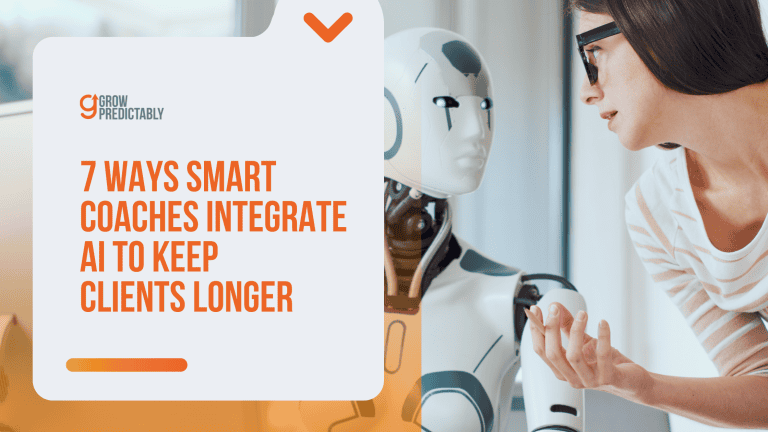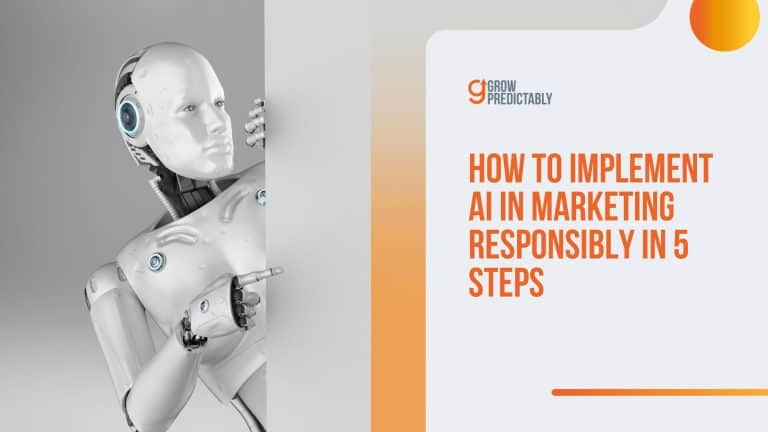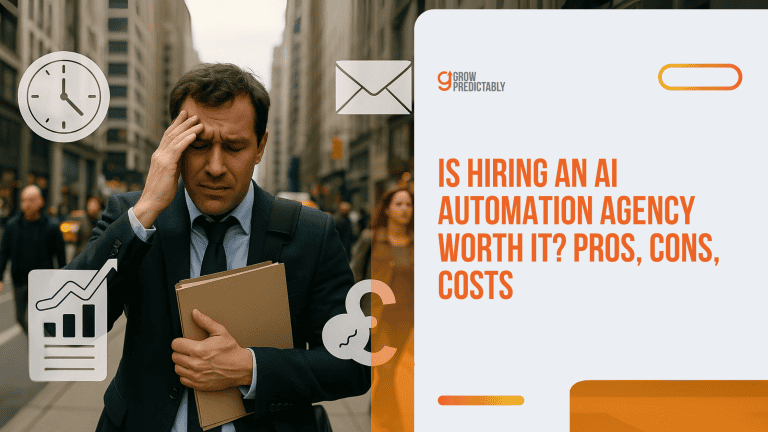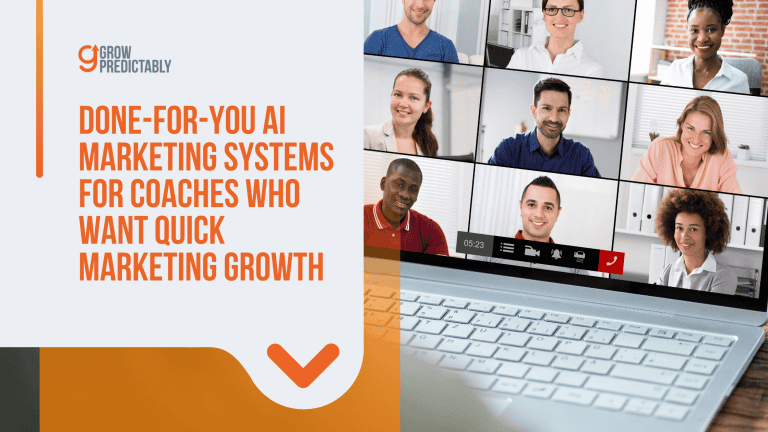Is AI Just a Trend? Future-Proofing a Coaching Practice
Did you know coaches who integrate AI workflow tools save an average of 15 hours per week on repetitive client management tasks?
The real challenge isn’t whether AI belongs in coaching—it’s that most practitioners treat it like an optional experiment instead of foundational infrastructure.
As a result, this leaves them manually juggling intake forms, progress tracking, and follow-up sequences while their most scalable competitors automate the entire client journey.
Future-proofing a coaching practice means answering “is AI just a trend” with strategic action…
Deploy automation for onboarding, use intelligent systems to monitor client momentum, and let AI handle routine touchpoints so you preserve energy for high-impact transformation work.
Grow Predictably helps coaches implement these systems through proven strategic frameworks that maintain personalization at scale, letting you serve dozens of clients without burning out or compromising quality.
Let’s build that system.
TL;DR
AI isn’t just a trend; it’s a pivotal tool for future-proofing your coaching business. By automating routine tasks, AI frees you to focus on high-impact, human-centered coaching, enhancing your unique value and specialization.
KEY TAKEAWAYS
- Embrace AI to automate routine tasks, freeing up time for high-value, human-centric coaching sessions.
- Define and communicate your unique coaching specialization, using AI insights to refine your niche and attract ideal clients.
- Use AI analytics to enhance client engagement by identifying patterns and tailoring your approach to meet clients’ specific needs and challenges.
Does ‘Manual‘ Always Mean ‘More Value‘ in Coaching?
Most coaches think personal service means doing everything by hand.
They believe if they’re not manually sending every email, personally reviewing every assessment, and individually tracking each client’s progress, they’re somehow providing less value.
This thinking keeps you stuck trading hours for dollars while your competitors scale past you.
The reality is simpler than you think.
Personal service isn’t about manual labor—it’s about consistent outcomes.
Even as you integrate AI and automation, maintaining the human touch in your coaching is essential.
Your clients don’t care if you personally sent their welcome email at 2 AM.
They care that they get exactly what they need, when they need it, every single time.
While AI can enhance efficiency, the human connection remains central to truly transformative coaching experiences.
Will Your Client Knowledge Help Maximize Your AI Systems?
Your ideal client profile isn’t just a marketing exercise—it’s your AI blueprint.
When you know exactly who you serve, you can program systems that anticipate their needs better than most humans ever could.
Think about it: your perfect client asks the same questions, hits the same roadblocks, and needs the same encouragement at predictable points in their journey.
Here’s what deep client knowledge unlocks for your AI systems:
- Predictive content delivery – Send the right resources before clients even know they need them
- Automated milestone celebrations – Recognize achievements that matter most to your specific audience
- Intelligent escalation triggers – Know exactly when human intervention adds the most value
- Personalized communication patterns – Match the tone and frequency your clients actually prefer
- Personalized learning paths – Create tailored training routes that adapt to each client’s needs, enabling self-paced skill development and addressing specific skills gaps
When you understand your customer avatar at this level, AI becomes your force multiplier instead of your replacement.
Understanding your client’s career aspirations allows AI to align coaching interventions and learning opportunities with their long-term goals, supporting both personal growth and organizational objectives.
You’re not automating everything—you’re automating the predictable parts so you can focus on the breakthrough moments that only you can create.
Does AI Diminish Value in Coaching?
Smart coaches use AI to create more personal experiences, not fewer ones.
Take client onboarding—the most critical 30 days of your relationship.
Manual onboarding means some clients get your A-game attention while others slip through the cracks depending on your energy levels and schedule.
AI-driven onboarding ensures every single client gets your best thinking, delivered consistently:
- Immediate welcome sequences that set expectations and build excitement from day one
- Progress tracking systems that celebrate small wins and identify potential dropout risks
- Customized resource delivery based on individual learning styles and pace preferences
- Intelligent check-in scheduling that prompts human touchpoints at optimal moments
AI systems can also deliver personalized feedback to clients during onboarding, helping them understand their progress and areas for improvement right from the start.
The result isn’t less personal connection—it’s more strategic personal connection.
Instead of spending time on administrative tasks, you’re having deeper conversations about breakthrough moments.
Your clients feel more supported because nothing falls through the cracks, and you feel more fulfilled because you’re doing the work that actually transforms lives.
Progress tracking follows the same principle.
Manual tracking means inconsistent follow-up and missed opportunities to course-correct before small issues become big problems.
AI systems monitor engagement patterns, completion rates, and outcome indicators 24/7.
They flag when someone needs encouragement, identify when they’re ready for the next challenge, and alert you to intervene at precisely the right moments.
AI provides real time feedback to both coaches and clients, enabling immediate course corrections.
Continuous feedback from AI systems ensures clients stay engaged and on track throughout their journey.
This isn’t about replacing your intuition—it’s about augmenting it with data that helps you make better decisions faster.
How Does The Customer Value Journey Help Create Client Transformations?
Your coaching business lives or dies on one thing: turning strangers into people who can’t stop talking about you.
Most coaches think this happens by accident—a client gets results, feels good, and maybe tells a friend.
That’s leaving money on the table and hoping for the best.
The coaches making seven figures understand something different.
They engineer transformation at every single touchpoint.
They know exactly what their ideal client needs to hear, when they need to hear it, and how to deliver it without burning themselves out.
The secret isn’t working harder—it’s working systematically through each stage of the customer value journey.
By focusing on business outcomes and demonstrating real, measurable results for your clients, you not only justify your coaching investment but also create a competitive advantage that sets your practice apart in the market.
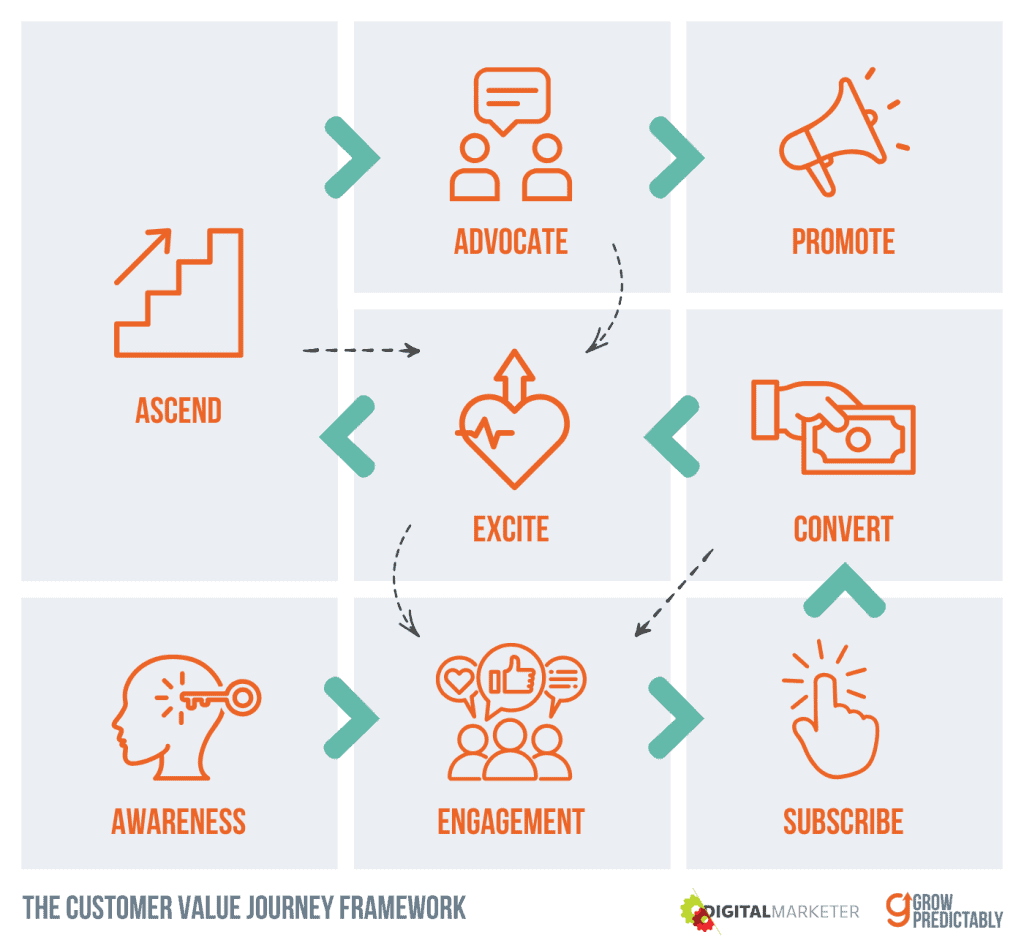
Awareness & Engage: Standing Out Without Burning Out
Your ideal client is drowning in coaching content.
They see the same generic posts about mindset and morning routines from dozens of coaches every day.
The ones who break through this noise don’t shout louder—they speak more precisely to exactly what their avatar is thinking.
AI transforms how you capture attention because it personalizes content creation at scale.
Leveraging AI-powered content creation allows you to produce high-quality, engaging materials efficiently and consistently, helping you stand out in a crowded market.
Instead of guessing what resonates, you can test different angles, analyze engagement patterns, and double down on what actually moves your specific audience.
Your content hits harder because it’s built on data about what your ideal client actually responds to, not what you think they should care about.
This isn’t about replacing your voice—it’s about amplifying it in ways that actually reach the right people.
Adopting innovative solutions like AI-driven engagement tools enables coaches to break through the noise and connect with their ideal clients more effectively.
Subscribe & Convert: Turning Interest Into Investment
The gap between someone finding you interesting and actually hiring you is where most coaches lose potential clients.
Manual follow-up means some prospects get your full attention while others get forgotten in your inbox.
Inconsistent nurturing kills conversions before they start.
AI-powered systems eliminate this randomness completely:
- Intelligent nurture sequences that adapt based on engagement levels and expressed interests
- Custom assessments that provide immediate value while gathering crucial data about readiness to buy
- Streamlined booking flows that remove friction and guide prospects toward the right conversation
- Behavior-triggered follow-ups that reach out when someone shows buying signals. AI can analyze coaching conversations to detect these signals, using insights from transcribed sessions to tailor follow-up strategies for each prospect.
The result is every prospect gets your best sales process, delivered with perfect timing.
You’re not chasing people or wondering who’s ready to move forward—the system tells you exactly when to have the right conversation.
Excite: Delivering Breakthrough Moments From Day One
Your clients hire you for transformation, but they judge you on the first week.
Manual client management means some people get quick wins while others struggle in silence until your next check-in.
That inconsistency kills momentum and breeds doubt about whether they made the right choice.
Smart coaches use AI to manufacture “aha!” moments systematically.
The technology monitors progress indicators, identifies breakthrough patterns, and delivers personalized insights at exactly the right time.
AI also provides actionable insights, helping clients connect their progress to their goals and enabling more effective, data-driven coaching.
When someone completes their first assessment, they don’t wait for your next session to understand what it means—they get immediate feedback that connects their results to their goals.
Milestone celebrations become automatic but feel completely personal.
The system recognizes when someone hits a significant marker and delivers recognition that matters to them specifically.
AI-driven recognition also supports improved knowledge retention by reinforcing key learning moments and making them more memorable.
This isn’t generic cheerleading—it’s targeted acknowledgment based on their individual journey and what you know motivates them most.
Ascend, Advocate, Promote: Turning Success Into Systematic Growth
Most coaches treat client success as the end of the journey.
The smart ones understand it’s actually the beginning of their marketing engine.
Happy clients become your best salespeople, but only if you systematically capture and leverage their enthusiasm.
AI systems excel at this because they never forget to ask and never miss an opportunity.
They also provide ongoing support to clients, offering continuous resources and regular check-ins to maintain engagement and satisfaction:
- Automated testimonial collection at peak satisfaction moments, not when you remember to ask
- Satisfaction monitoring that identifies advocacy opportunities before clients even realize they want to share
- Engagement tracking that spots clients ready for advanced programs or referral conversations
- Social proof amplification that turns individual wins into compelling marketing content
According to a Nielsen 2021 Trust In Advertising Study, 88% of people trust recommendations from people they know over any other form of marketing. (Source)
Your AI systems ensure you never miss a chance to turn client success into systematic business growth.
The key is understanding your avatar deeply enough to know what kinds of wins they want to celebrate publicly and how they prefer to share their success.
AI systems can generate valuable insights into client preferences, helping you tailor advocacy strategies for maximum impact.
When you know this, technology can facilitate advocacy in ways that feel natural and authentic to your specific client base.
How Can You Blend Human Expertise with Smart AI?
Every successful coach eventually hits the same wall.
You’re spending more time on spreadsheets than strategy sessions.
Your days fill up with reminder texts, progress updates, and administrative tasks that don’t actually help anyone transform their life.
Meanwhile, the work that made you fall in love with coaching—those breakthrough conversations and lightbulb moments—gets squeezed into whatever time remains.
Today, AI coaching and AI powered coaching are becoming essential components of the modern coach’s toolkit, offering personalized, scalable support that enhances both employee wellbeing and organizational performance.
The coaches scaling past this problem aren’t hiring armies of assistants or working 80-hour weeks.
They’re strategically dividing their time between what machines do better and what only humans can do.
AI powered solutions streamline operations, automate repetitive tasks, and free up valuable time for high-impact coaching work.
This isn’t about replacing your expertise—it’s about protecting it from getting buried under routine tasks.
Where AI Becomes Your Operations Team
Think about your typical client interaction.
How much of it involves tasks that follow predictable patterns?
Someone fills out intake forms, you send reminder messages, they complete assignments, you update their progress dashboard, and you schedule the next check-in.
These steps matter, but they don’t require your years of training or intuitive understanding of human psychology.
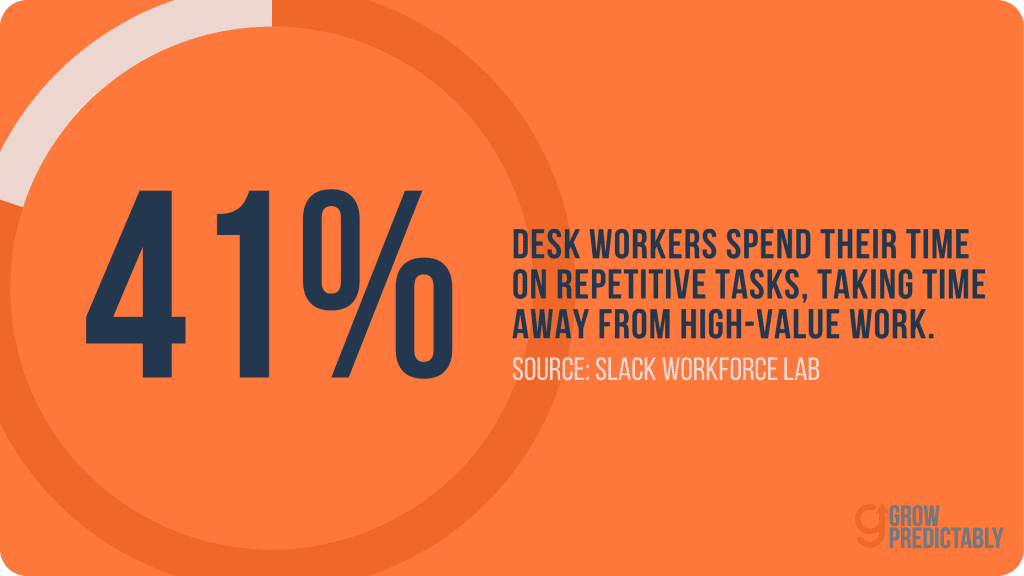
AI systems handle these routine touchpoints with perfect consistency:
- Intake automation that gathers comprehensive client information and identifies key patterns before your first conversation. Machine learning algorithms and predictive analytics can analyze intake data to identify client patterns and forecast future needs, enabling more personalized and proactive support.
- Progress dashboards that update in real-time and flag important changes without manual data entry. AI driven analytics and advanced analytics provide deeper insights into client engagement and outcomes, helping you optimize coaching strategies based on actionable data.
- Reminder systems that adapt to individual preferences and engagement patterns
- Administrative workflows that handle scheduling, payments, and resource delivery seamlessly
According to Slack Workforce Lab, workers spend an average 41% of their time on repetitive tasks, ‘leading to wasted time, missed revenue, and sometimes even unhappy customers.’ (Source)
For coaches, this percentage often runs even higher because client management involves so many routine but necessary touchpoints.
When these systems run automatically, something interesting happens.
Your clients actually feel more supported, not less.
They get consistent communication, never miss important reminders, and can track their progress without waiting for your updates.
The experience feels more professional and organized because it is.
Where Your Human Expertise Becomes Irreplaceable
While AI handles the predictable parts of coaching, it can’t read between the lines of what someone isn’t saying.
It can’t sense when a client’s energy shifts during a conversation or recognize that their resistance to a particular exercise stems from deeper fears they haven’t articulated yet.
This is where your value becomes most apparent and most profitable.
Your irreplaceable contributions center on moments that require emotional intelligence and strategic thinking.
When a client hits an unexpected roadblock, AI might flag the pattern, but you understand the psychology behind why they’re stuck.
When someone achieves a breakthrough, AI can celebrate the milestone, but you can help them process what it means for their identity and future decisions.
The nuanced guidance that transforms lives happens in conversations that feel less like coaching sessions and more like strategic partnerships.
Coaching helps clients develop self awareness and leadership skills, providing personalized strategies for growth that technology alone cannot deliver.
You’re not walking them through basic progress updates or reminding them about homework—that’s already handled.
Instead, you’re diving deep into the mindset shifts, behavioral patterns, and strategic decisions that create lasting change.
Human coaches are uniquely equipped to help clients navigate individual challenges that AI cannot fully address.
Freedom to Focus on What Actually Transforms Lives
When routine touchpoints run automatically, your coaching sessions transform completely.
Instead of spending 15 minutes reviewing what happened since your last call, you’re immediately focused on breakthrough moments and strategic decisions.
Your clients come prepared because the AI systems have guided them through reflection exercises and progress reviews beforehand.
This preparation level creates deeper conversations because everyone understands where things stand before you even start talking.
You can spend your time on the complex human elements that actually drive transformation—helping someone navigate conflicting priorities, reframe limiting beliefs, or develop strategies for situations that don’t fit standard frameworks.
The relationship deepens because your time together becomes more valuable and focused.
Clients see you as the strategic partner who helps them navigate complex decisions, not the administrative coordinator who reminds them about assignments.
By delivering personalized guidance that empowers employees to achieve their goals, you further strengthen your role as a trusted advisor.
This positioning naturally supports higher fees because the value you provide becomes more concentrated and irreplaceable.
Your breakthrough conversations happen more frequently because AI systems identify optimal timing for human intervention.
By focusing on developing skills, you ensure clients experience meaningful, lasting transformation.
Instead of scheduled check-ins regardless of where someone is in their journey, you connect with clients when they’re most ready for guidance or most in need of support.
How to Setup Your Roadmap for Personalized Learning and Coaching with AI Without Losing Your Essence

Your calendar controls your life instead of the other way around.
Client management feels like herding cats.
You’re answering the same questions for the twentieth time this month while your most impactful work gets pushed to tomorrow’s already-packed schedule.
This stops now.
Effective training programs and modern training approaches are essential for skills development in a future-proof coaching practice.
The roadmap below transforms chaos into systems that work for you, not against you.
1. Identify Your Pain Points
Most coaches know they’re drowning but can’t pinpoint exactly where the water’s coming in.
Spend three days tracking every task that makes you think “there has to be a better way.”
You’ll discover patterns that shock you.
The biggest time drains usually cluster around these areas:
- Scheduling nightmares where you send five emails to book one appointment
- Invoice chasing that turns you into a reluctant bill collector
- Repetitive onboarding where you explain the same process multiple times per week
- Generic follow-ups that feel copy-pasted even when you write them fresh
Write down every task that feels mechanical or repetitive.
Don’t filter—just capture everything.
The goal isn’t to automate your entire practice overnight.
It’s to identify where your human expertise gets wasted on robot work.
Addressing these pain points is essential for effective workforce development and sustainable growth, ensuring your team is prepared for future challenges and long-term success.
2. Choose Beginner-Friendly Tools
Forget the complex software suites that require three training courses and a computer science degree.
Start with tools designed for humans, not engineers.
These three solve the biggest headaches without creating new ones:
- Calendly eliminates scheduling torture by letting clients book directly into your available slots
- ChatGPT drafts content that sounds like you once you teach it your communication style
- CoachAccountable handles client check-ins and progress tracking without manual spreadsheet updates
Coaches can also explore advanced technologies like augmented reality, virtual reality, and natural language processing to further enhance their practice, offering immersive learning experiences, realistic simulations, and AI-powered content creation.
Each tool tackles one specific problem.
You’re not rebuilding your entire practice—you’re fixing the parts that frustrate you most.
According to Salesforce IT Leaders Fueling Productivity With Process Automation, 73% of IT leaders credit automation for helping save 10-50% of time previously spent on manual tasks. (Source)
Pick one tool and ignore the others for now.
Master walking before you try running.
3. Start With Small Pilots
Testing everything at once guarantees nothing works well.
Launch focused experiments that won’t crash your business if they fail.
Try a 14-day sprint with your chosen tool.
Set specific parameters: use ChatGPT to draft follow-up emails but don’t send anything without reviewing it first.
Let Calendly handle new client scheduling but keep existing clients on your current system until you’re confident.
Document what works and what doesn’t.
Small pilots can also reveal opportunities for ongoing support and continuous learning for both coaches and clients, helping you identify where additional resources or regular check-ins may be needed.
Does the AI-drafted email capture your tone?
Does automated scheduling reduce back-and-forth or create new confusion?
Small pilots give you data instead of guesswork.
The key is starting with low-risk, high-impact experiments.
You want quick wins that build confidence, not disasters that make you swear off technology forever.
4. Align AI With Your Voice
Generic AI output sounds robotic because you haven’t taught it to sound like you.
Most coaches skip this step and wonder why their automated messages feel cold.
Create a simple voice guide that captures how you actually communicate.
Include phrases you use frequently, your typical email structure, and examples of how you give feedback or celebrate client wins.
Compile your coaching materials, such as FAQs and methodology guides, to help train AI systems to better reflect your unique style.
This becomes your AI training manual.
When you ask ChatGPT to draft something, include relevant parts of your voice guide in the prompt.
The difference in output quality will amaze you.
The tool starts generating content that sounds like it came from your brain, not a customer service bot.
This isn’t about making AI perfect—it’s about making it useful enough to save you time while maintaining your unique style.
5. Get Feedback From Clients
Your assumptions about what clients notice might be completely wrong.
Some worry that AI makes interactions feel impersonal, while others appreciate faster responses and more consistent communication.
After implementing a new tool, ask direct questions about their experience.
Did the automated scheduling feel smooth or confusing?
Was the AI-drafted follow-up helpful or generic?
Did anything feel different about the overall process?
Client feedback often reveals unexpected benefits.
They might love getting immediate confirmation emails or appreciate that nothing falls through the cracks anymore.
AI-driven improvements like these often lead to improved employee satisfaction by making processes smoother and more responsive.
This feedback helps you double down on what works and fix what doesn’t.
Remember that most clients care more about results and consistency than whether you personally typed every email.
They hired you for transformation, not administrative perfection.
6. Scale Gradually
Success with one tool doesn’t mean you should immediately add five more.
Build on proven wins by expanding existing systems before introducing new ones.
Companies investing in AI-driven systems often see greater efficiency and long-term benefits, as strategic adoption leads to sustained growth and a competitive edge.
Once automated scheduling runs smoothly, consider adding automated reminders.
When AI-drafted emails consistently match your voice, explore content personalization based on client progress.
Each addition should solve a specific problem you’ve identified, not just add features because they exist.
Your implementation checklist keeps you focused:
- Identify three specific tasks that drain energy without adding client value
- Test one solution for 14 days with clear success metrics
- Document your communication style so AI can match your voice
- Set boundaries for what gets automated versus what stays personal
- Collect client feedback after each implementation
- Review and adjust monthly instead of setting and forgetting
Based on the research I’m Only Human: The Role of Technology in Coaching, technology can enhance client-coach relationships and improve goal attainment when integrated correctly. (Source)
The key word is thoughtfully—not desperately or reactively.
Each step builds systematic improvements without overwhelming your current operations.
You’re not replacing your coaching expertise—you’re protecting it from getting buried under administrative tasks that don’t require human intelligence.
Why Coaches Shouldn’t Fear AI and How to Stand Out?
The nightmare scenario keeps coaches awake at night: AI becomes so good at giving advice that clients stop paying premium fees for human guidance.
You picture a future where anyone can get personalized coaching for $29 a month from a chatbot that never takes vacation days or has off moments.
As future trends and technological advancements like AI-driven coaching platforms and virtual reality tools continue to reshape the industry, it’s crucial to stay ahead by understanding and leveraging these changes.
This fear misses the point entirely.
AI won’t commoditize coaching any more than calculators commoditized accounting or GPS commoditized navigation.
The professionals who thrived weren’t the ones who could do basic math faster—they were the ones who used new tools to deliver higher-level value that nobody else could provide.
Your survival depends on understanding what your ideal clients actually buy from you.
Spoiler Alert: it’s not generic life advice they could get from a self-help book or AI assistant.
Dr. Marshall Goldsmith adds to this point best…
This is why, for the highly-acclaimed executive coach, the relational and intuitive aspects of coaching remains irreplaceable. (Source)
What Your Clients Really Pay For
Most coaches think they sell problem-solving, but clients don’t hire you to solve problems they could Google.
They hire you to navigate the messy, complicated, deeply personal journey of becoming someone different.
Understanding different learning styles allows you to tailor your coaching approach for maximum impact, ensuring each client receives support in a way that resonates with them.
AI can suggest morning routines, but it can’t hold space for someone’s fear of success or help them process childhood patterns that sabotage their relationships.
Your Avatar Canvas reveals what your ideal clients desperately want but can’t articulate clearly.
They might say they want better time management, but what they really want is to feel like they’re living their life instead of just surviving it.
They claim they need confidence, but they’re actually seeking permission to want what they want without apologizing for it.
These deeper desires create your competitive moat because they require human understanding, intuition, and the ability to read between the lines of what someone says versus what they mean.
AI processes words—you process humans.
Where Does Your Value Lie as a Coach?
Your unique value isn’t in what you do—it’s in how your specific background, personality, and approach creates results for your particular type of client.
The mistake most coaches make is trying to be everything to everyone instead of becoming indispensable to someone specific.
Start by examining your best client relationships and identifying patterns that have nothing to do with your standard coaching curriculum:
- What personal experiences allow you to understand their struggles in ways other coaches can’t
- Which moments in sessions create the biggest breakthroughs for your clients specifically
- What aspects of your personality help certain types of people feel safe enough to change
- Which of your unconventional approaches consistently produce results others don’t achieve
Your edge often lives in the intersection of your personal story and your professional skills.
A key differentiator is how you approach skill development—by tailoring it to close specific competency gaps and accelerate growth for your clients, you offer more than generic coaching methods.
Maybe you’re the coach who helps high-achievers without burning them out because you’ve actually been there.
Or you specialize in helping people navigate career transitions because you’ve reinvented yourself multiple times.
The key is getting specific about who you serve and why you’re uniquely qualified to serve them.
Generic coaches get replaced by AI.
Specialists become more valuable as the market gets noisier.
How Do You Communicate Your Unique Position?
Once you understand your edge, you need to communicate it in ways that make your ideal clients think “this person gets me” instead of “this sounds like every other coach.”
Most coaches make their marketing about their credentials or methods instead of the specific transformation they create for specific people.
Your messaging should make your ideal clients feel seen and understood before they even book a call.
Instead of saying “I help people achieve their goals,” try “I help burned-out executives rediscover what they actually want their career to look like without starting over from scratch.”
The specificity scares away people who aren’t a perfect fit—which is exactly the point.
You want to repel the wrong clients as much as you want to attract the right ones.
And this can be achieve through positioning and knowing the core of your target audience.
Generally, businesses with clear positioning and target audiences achieve higher revenue growth than those trying to appeal to everyone. (Source)
Your unique position becomes your filter for everything: which clients you take, what programs you create, how you price your services, and what partnerships make sense.
Aligning your coaching services with your clients’ business objectives further strengthens your market position by ensuring your offerings directly support their strategic goals.
When you stand for something specific, everything else becomes clearer.
Using AI to Deliver Valuable Insights and Deepen Your Specialization
Here’s where it gets interesting: AI doesn’t threaten your specialization—it enhances it.
The technology can process patterns in your client data that would take you months to identify manually, revealing insights that help you serve your niche even better.
AI systems can analyze client progress patterns and identify which interventions work best for different personality types or life situations.
AI can also identify skill gaps and skills gaps within your clients, allowing you to address these areas to improve employee performance and employee productivity.
They can track language patterns in your successful client communications and help you replicate that approach with new clients.
They can even identify early warning signs of clients who might not be a good fit, saving you both time and frustration.
The key is using these insights to become more specialized, not more generic.
When AI shows you that clients with certain characteristics respond better to specific approaches, you can refine your methods and messaging to attract more of those ideal clients.
Smart coaches use AI to:
- Identify their highest-value client patterns and focus marketing on attracting more of those people
- Refine their methodology based on what actually produces results for their specific niche
- Personalize their approach within their specialty instead of trying to serve everyone the same way. AI enables you to deliver personalized guidance tailored to each client’s unique needs.
- Predict client needs and proactively address challenges before they become problems
This creates a feedback loop where you become increasingly valuable to your ideal clients while becoming less relevant to everyone else.
That’s not a bug—it’s a feature.
The coaches who try to serve everyone equally will find themselves competing on price with AI tools.
Those who use AI to serve their ideal clients better will find themselves in a category of one.
Your specialization becomes your protection.
When you’re known as the go-to expert for a specific type of transformation with a specific type of person, you’re not competing with AI or other generic coaches.
You’re competing with doing nothing, and your track record of results makes that an easy choice for your ideal clients.
FAQs
The Future Proof Choice That Defines Your Next Decade
The coaching industry is splitting into two groups right now.
One group debates whether AI threatens their business while drowning in administrative tasks.
The other group uses AI to handle routine work while focusing on the breakthrough moments that actually transform lives.
AI isn’t just a trend—it’s the toolkit that separates elite coaches from everyone else.
Your Customer Avatar becomes your AI blueprint, and the Customer Value Journey ensures every automated touchpoint serves your client’s transformation.
Your human expertise becomes more valuable when routine tasks run automatically.
Clients don’t hire you to send reminder emails—they hire you for insights, empathy, and strategic thinking that only experience can provide.
The winners won’t be coaches with the fanciest tools.
They’ll be the ones who use AI to amplify their unique strengths while serving ideal clients better than ever before.
Embrace the change and lead, or resist it and get left behind.
The choice is yours.





![7 Best AI Story Generators in 2025 for Your Next Story [Ranked]](https://growpredictably.com/wp-content/uploads/2024/11/AI-Story-Generators-in-2025-768x432.jpg)
